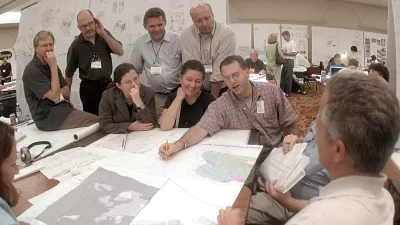Exclusives
BLOG POST
Here's to the Visionaries
As the president and co-founder of Friends of the High Line prepares to leave the park he helped to create, it is a good time to consider the legacy of what is now one of the most famous contemporary landscapes in the world.
BLOG POST
Who Subsidizes Whom?
This column expands on issues raised in a previous Planetizen blog, "Mythbusting: Exposing Half-Truths That Support Automobile Dependency," which examined criticisms of cycling facility investments and justifications for automobile-oriented planning.
BLOG POST
Recovering Housing Market Gets Smart
As the housing market recovers, are we back to the McMansion-binges of the 2000s? Or, are we growing just a little bit smarter?
BLOG POST
Mythbusting: Exposing Half-Truths That Support Automobile Dependency
Some commentators recently expressed outraged that governments spend money on cycling facilities. Their arguments are largely wrong, I’ll call them "half-truths" to be charitable, presented with great certitude and self-righteous anger.
BLOG POST
Traversing the Border: Planning with Transnational Communities
Transnational communities transcend borders in order to act collectively, despite geographic, economic and political challenges. A new paper examines how community-based planning is scaled up and embedded in transnational processes and relationships.
BLOG POST
Blame Single-Family Neighborhoods for Gentrification
What's so special about single-family homes that we'd rather preserve them than prevent the displacement and financial distress of thousands of low- and moderate-income renters?

FEATURE
The Challenges of Re:Coding L.A.
A comprehensive zoning rewrite is a complex undertaking for any city. But for one that’s seeking to evolve its land use and transportation patterns, and is as physically and demographically diverse as L.A., a unique set of challenges has emerged.
BLOG POST
Green Urbanism is the Future! Well, maybe.
Students of landscape architecture are obsessed with cities and all things green - at least according to recent design awards. But are they forgetting about design?
BLOG POST
Three Quick Wins for Auckland (or Any City’s) Walkability
The following “top three” relatively quick wins for a more walkable city, written below from the perspective of Brent’s observations, reflect some relatively low-cost opportunities toward a more liveable & successful Auckland.
BLOG POST
Who Is Migrating To Cities?
Millenials really are migrating to cities in large numbers- but older age groups are merely leaving less rapidly than in the past.
BLOG POST
Secure the Terminal, Secure the City
Some of the reactions to the shooting at LAX revealed troubling attitudes towards public space. Inclined as we may be to tighten security, we ought not sacrifice the richness of public life in the name of safety -- even at an airport.
BLOG POST
The Google Barge and the Future of Mobile Retail
The Google Barge is fascinating not for what it is but what it could herald: a future where our retail stores come to us rather than us to them.
BLOG POST
JPER’s Top Cited Articles: The Debate over Communicative Planning
JPER has existed since the early 1980s but 4 of the top 5 articles date from the mid-1990s to the early 2000s and focus on the theory behind collaboration and communication in planning.
BLOG POST
How Many Bicycles Can Park In The Space Required By One Car? Don’t Ask PolitiFact.
PolitiFact holds politicians accountable for their claims, but how accountable is PolitiFact? Not very. It inaccurately answered a simple planning question, and was unwilling to clarify or correct its false judgment.
BLOG POST
The Irony of Ring Roads
One way to address traffic congestion is to provide a bypass for vehicles around city traffic machinations. Ring roads, by definition, are meant to perform that function. In reality, they ignore the supply and demand model of traffic management.

FEATURE
What Is Planning?
By analyzing the areas of expertise and interests of 851 undergraduate and graduate planning faculty members, Tom Sanchez investigates what planning is, what it is not, and what it could be.
BLOG POST
A Problem Statement about Problem Statements
Do you really want to solve the Big Problem in your city? If so, maybe the best way is to stop thinking about it.
BLOG POST
Low Crime Rates In Large Cities Support Multi-Modal Planning and Smart Growth
Contrary to popular assumptions, large, transit-oriented cities have lower crime rates than smaller, automobile-oriented cities. Jane Jacobs was right! This column discusses this phenomenon and its implications for transport and land use planning.
Pagination
Clanton & Associates, Inc.
Jessamine County Fiscal Court
Institute for Housing and Urban Development Studies (IHS)
City of Grandview
Harvard GSD Executive Education
Toledo-Lucas County Plan Commissions
Salt Lake City
NYU Wagner Graduate School of Public Service
Urban Design for Planners 1: Software Tools
This six-course series explores essential urban design concepts using open source software and equips planners with the tools they need to participate fully in the urban design process.
Planning for Universal Design
Learn the tools for implementing Universal Design in planning regulations.


































